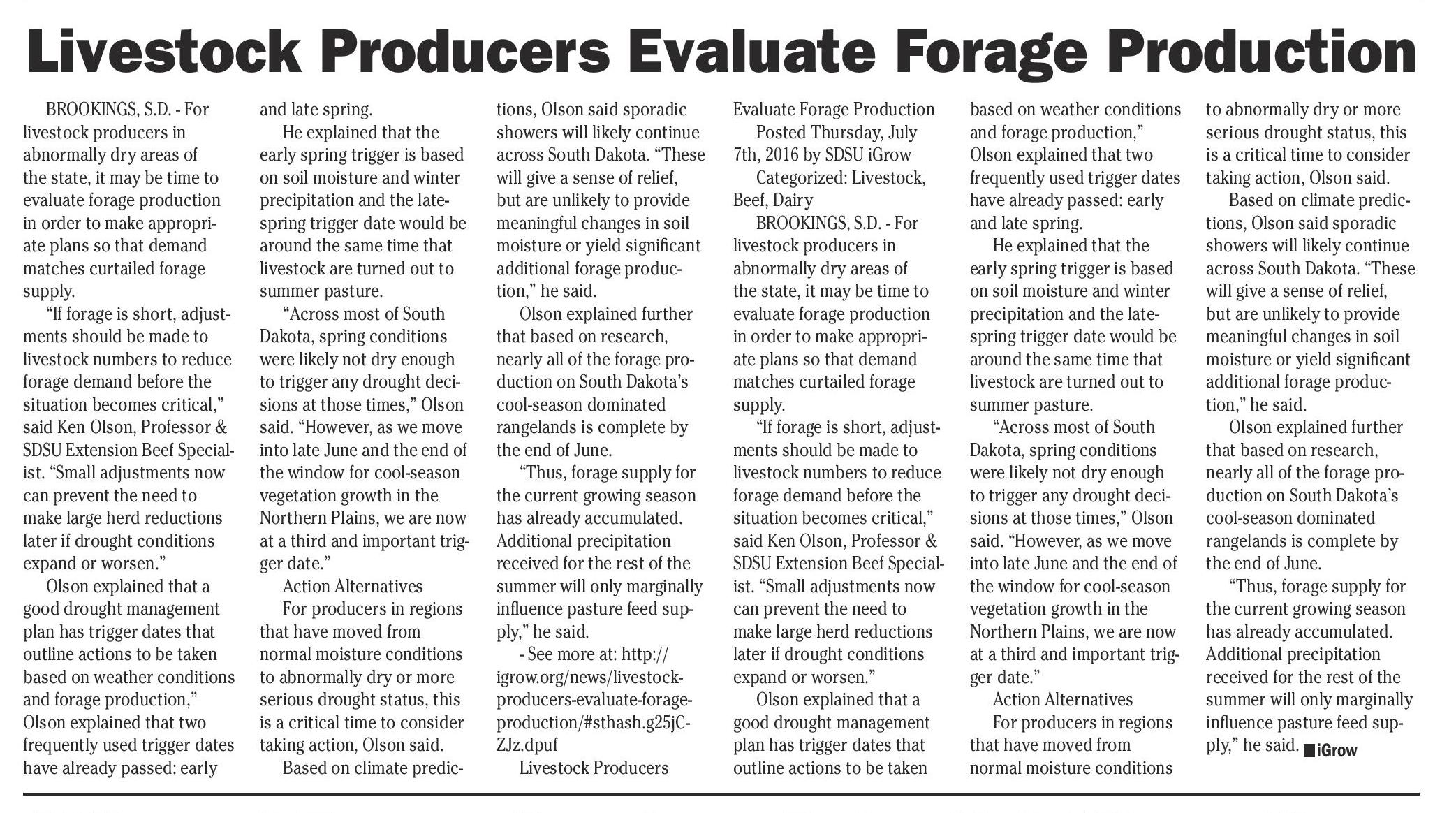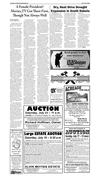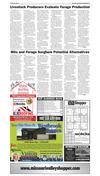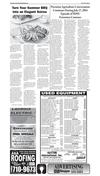12







in
t?
re.
July 12, 2016 • Page 12
shop online at www.missourivalleyshopper.com
Livestock Producers Evaluate Forage Production
BROOKINGS, S.D. - For
livestock producers in
abnormally dry areas of
the state, it may be time to
evaluate forage production
in order to make appropriate plans so that demand
matches curtailed forage
supply.
“If forage is short, adjustments should be made to
livestock numbers to reduce
forage demand before the
situation becomes critical,”
said Ken Olson, Professor &
SDSU Extension Beef Specialist. “Small adjustments now
can prevent the need to
make large herd reductions
later if drought conditions
expand or worsen.”
Olson explained that a
good drought management
plan has trigger dates that
outline actions to be taken
based on weather conditions
and forage production,”
Olson explained that two
frequently used trigger dates
have already passed: early
and late spring.
He explained that the
early spring trigger is based
on soil moisture and winter
precipitation and the latespring trigger date would be
around the same time that
livestock are turned out to
summer pasture.
“Across most of South
Dakota, spring conditions
were likely not dry enough
to trigger any drought decisions at those times,” Olson
said. “However, as we move
into late June and the end of
the window for cool-season
vegetation growth in the
Northern Plains, we are now
at a third and important trigger date.”
Action Alternatives
For producers in regions
that have moved from
normal moisture conditions
to abnormally dry or more
serious drought status, this
is a critical time to consider
taking action, Olson said.
Based on climate predic-
tions, Olson said sporadic
showers will likely continue
across South Dakota. “These
will give a sense of relief,
but are unlikely to provide
meaningful changes in soil
moisture or yield significant
additional forage production,” he said.
Olson explained further
that based on research,
nearly all of the forage production on South Dakota’s
cool-season dominated
rangelands is complete by
the end of June.
“Thus, forage supply for
the current growing season
has already accumulated.
Additional precipitation
received for the rest of the
summer will only marginally
influence pasture feed supply,” he said.
- See more at: http://
igrow.org/news/livestockproducers-evaluate-forageproduction/#sthash.g25jCZJz.dpuf
Livestock Producers
Evaluate Forage Production
Posted Thursday, July
7th, 2016 by SDSU iGrow
Categorized: Livestock,
Beef, Dairy
BROOKINGS, S.D. - For
livestock producers in
abnormally dry areas of
the state, it may be time to
evaluate forage production
in order to make appropriate plans so that demand
matches curtailed forage
supply.
“If forage is short, adjustments should be made to
livestock numbers to reduce
forage demand before the
situation becomes critical,”
said Ken Olson, Professor &
SDSU Extension Beef Specialist. “Small adjustments now
can prevent the need to
make large herd reductions
later if drought conditions
expand or worsen.”
Olson explained that a
good drought management
plan has trigger dates that
outline actions to be taken
based on weather conditions
and forage production,”
Olson explained that two
frequently used trigger dates
have already passed: early
and late spring.
He explained that the
early spring trigger is based
on soil moisture and winter
precipitation and the latespring trigger date would be
around the same time that
livestock are turned out to
summer pasture.
“Across most of South
Dakota, spring conditions
were likely not dry enough
to trigger any drought decisions at those times,” Olson
said. “However, as we move
into late June and the end of
the window for cool-season
vegetation growth in the
Northern Plains, we are now
at a third and important trigger date.”
Action Alternatives
For producers in regions
that have moved from
normal moisture conditions
to abnormally dry or more
serious drought status, this
is a critical time to consider
taking action, Olson said.
Based on climate predictions, Olson said sporadic
showers will likely continue
across South Dakota. “These
will give a sense of relief,
but are unlikely to provide
meaningful changes in soil
moisture or yield significant
additional forage production,” he said.
Olson explained further
that based on research,
nearly all of the forage production on South Dakota’s
cool-season dominated
rangelands is complete by
the end of June.
“Thus, forage supply for
the current growing season
has already accumulated.
Additional precipitation
received for the rest of the
summer will only marginally
influence pasture feed supply,” he said. niGrow
Milo and Forage Sorghum Potential Alternatives
BROOKINGS, S.D. - Forage
and grain sorghum may be
potential alternatives for
forage production in dry
conditions, explained Karla
Hernandez, SDSU Extension
Forages Field Specialist.
“The current dry conditions in northeastern and
western South Dakota have
some livestock producers
looking for more droughtresistant forage crops they
can plant in the future,”
Hernandez said.
As its name indicates,
grain sorghum, also called
milo, is typically harvested
for grain. Forage sorghum is
taller and typically used for
silage.
Below Hernandez explains the benefits of raising
sorghums over corn as well
as the best management
practices for each.
Forage sorghum
Forage sorghum can be
grown either as grain or forage crop.
“The advantage of its
use over corn is that it
requires less water, and it
is drought tolerant by going
semi-dormant which makes
it a good fit for dryland and
limited irrigation situations,”
she said.
Hernandez added that
sorghum has fewer input
We’ve
Got You
Covered
FREE Inspections/Estimates
costs, tolerates moderately acid and low fertility
soils (yet responds well to
fertilization), and it can be
harvested multiple times
because of its regrowth
potential.
“Forage sorghum also
makes excellent hay for
supplemental feeding during
times of inadequate or low
forage production,”
Perhaps the greatest
advantage of sorghum,
Hernandez highlights is the
diverse management options
that the grower can choose
from in order to match their
production needs.
Forage Sorghum Management
Forage sorghum should
be planted in spring when
soil temperatures exceed 60
degrees Fahrenheit at 0.5- to
2.0-inches deep. Seeds may
be drilled, broadcasted, or
planted in rows spaced 15 to
40 inches apart at a rate of
15 to 25 pounds per acre.
Harvest when the whole
plant moisture content is
We Install/Repair
Roofs Of All Kinds!
between 63 to 68 percent.
The recommended stage
of maturity for harvesting
forage sorghum to optimize
dry matter content and
nutrient quality is when the
grain reaches early to late
dough stage.
“Harvesting earlier during
the late vegetative or early
head stage of maturity will
result in silage with very low
dry matter content of less
than 25 percent dry matter,
which will result in excess
seepage and an undesirable fermentation including
higher concentrations of
acetic and butyric acid,” she
said.
Wilting is recommended
if harvesting is going to occur at this stage. “If harvested at the hard dough stage,
the forage will have higher
dry matter content, but the
grain and stems will be more
mature and less digestible,”
Hernandez said.
She added that rolling
grain sorghum silage that is
in late dough or hard-grain
stages of maturity will improve grain digestibility and
support improved animal
performance.
Prussic Acid Concerns
Prussic acid is a problem
in young and active growing
tissues. The problem can
be avoided by not grazing
sorghum until plants have
reached 18 to 24 inches tall.
Cutting for hay or silage
generally alleviates the
problem because the toxin
is released and volatilizes
during handling.
Grain Sorghum (Milo)
Book 61
Some of the advantages
of producing grain sorghum
over corn in dry conditions
Sudoku #5
are:
8
* Sorghum is self-pollinated and produces heads
6
7
over a longer period of
time, while corn is cross9 5
pollinated. A severe drought
at silking time may2
cause the
absence of kernels.
* Short periods 6
8 of
drought do not damage sor4
ghum pollination and fertilization. In a longer drought,
Book 61: Answers
sorghum produces smaller
heads but none of them are
Sudoku #1
7
5
7 8 1 2 9
without kernels.6 5 3 4
HOT SUMMER BUYS
2014 Buick Encore, White, AWD, 1.4L turbo, rear camera, 37K,* .................$14,500
2013 Chevy Equinox, White, AWD, 2.4L auto, new tires ...............................$13,500
2013 Chevy Impala LT, Silver, full power, remote start, 56K..........................$11,995
2012 Ford Fusion SEL, White, leather, full power, V6, 76K ............................$10,500
2011 Chevy Impala LT, Silver, leather, moon roof, full power, 55K .................$11,995
2011 Chevy Silverado, Gray, C1500 reg. cab, longbox, V6, auto, w/t,* .........$12,500
2009 Chevy Silverado, K1500, white, 4x4, w/t, V8, auto, reg. cab,
longbox, 102,000 miles.............................................................................$11,900
2004 Chevy Silverado, C1500, white, ext. cab, 5.3L, auto, full power, bucket seats,
console, 122,000 miles, bed cover, new tires ................................................$7,995
*Salvage Title
Call Justus 605-857-1472
Family Owned – Locally Operated
Licensed/Bonded/Insured
605-665-3720 • Yankton, SD
Your New Home At... Westbrook
Estates
Located On West City Limits Road
Sudoku #3
6 4 5 7
9 7 3 1
2 8 1 3
5 6 2 4
7 1 9 5
8 3 4 6
4 2 7 9
3 5 6 8
1 9 8 2
9
Economic Development
2
6
4
6
9
8
1
3
4 8
1
62
9 3
8 2
5 9
3 7
2 6
7 5
1 8
4 1
6 4
2
Sudoku #4
8 9 2 5
3 1 4 6
7 5 6 3
4 2 8 1
6 3 5 7
9 7 1 2
2 8 7 9
5 6 3 4
1 4 9 8
8
5
7 4
8
5
1
3
9
9
5
8
3
1
7
2
9
3
7
6 8 2 5 3 7
7 9 8 4 5 6 1 3
4 6 1 2 7 3 9 5
5 2 3 9 1 8 6 4
8 7 9 3 6 4 2 1
6 5 2 1 9 7 4 8
INTERMEDIATE
3 1 4 5 8 2 7 9
Last Tuesday’s
Sudoku Solution
#7
3
7
1
4
5
2 7 1 6
5 9 3 2
4 8 6 5
1 6 8 9
7 2 5 1
9 3 4 7
1
4
6
7
2
5
7 2 1 4
5 3 9 4 1
2 5 6 8 7
6 2 1 3 9
4 8 7 5 6
1 9 4 6 3
3 1 5 2 8
8 4 3 7 5
7 6 8 9 2
9
9
2
6
7 3
7
5
3
6
5
6
2
3 9
7 4
2 1
5 8
4 7
9
3
8
6
6
3 8
5
4
6
7
5
1
5 7
8
3 9
4
5
9
4 9
1 8
7
Sudoku #8
7 2 1 8 4
8 9 5 7 2
6 4 3 5 1
© 2008 5 7 2 1 6
KrazyDad.com
3 1 9 2 7
4 6 8 9 3
1 3 7 4 8
2 5 4 6 9
9
BOOK 61 #78 6 3 5
#8
7
su do ku
6 5 9
3 1 6
9 8 7
8 4 3
4 6 8
5 7 2
2 9 5
7 3 1
1 2 4
3
4
1
2
1
6
KRAZYDAD.C
2
9
5
Check next Tuesday’s paper for1
the solution to today’s puzzle. 6
6
1
3
9 5 2 8
2 4 1 9
6 9 5 7
4 2 8 1
8 3 6 4
3 1 4 5
7 8 9 2
5 7 3 6
1
9 1 2 7 3
2 3 7 5 4
8 4 3 9 6
6 5 1 8 2
6 5 9 8 1 2 4 3 7
©
8 2008 7
4 KrazyDad.com
5 6
INT BOOK3 61 #79 2 1
3 1 2 4 7 9 8 6 5
8
8
4
7
8
3
7
34
3 5
9
5
6 5
1
9 21
Sudoku 3
#6
1
4
1 65
7 3 2
9
Sudoku #5 6
7 6 3 1 5
4
2 4 9 816 5
2
2
This home offers an open floor plan with 2 bedrooms, full bath, kitchen, dining and living room
all on the main floor. Kitchen features a center island and sliding doors just off the dining area
to the deck. Stove, refrigerator, dishwasher and microwave included. Laundry in lower level.
Future lower level finish could include 1 additional bedroom, full bath and a family room.
3
Easy Sudoku Puzzles by KrazyDad
MV Shopper
MV Shopper
1 4
5 8
3 9
7 2
9 6
ankton Area Progressive Growth
n
4 8
Sudoku #2
9 9 6
7
4
3
9
2
1 7
8 7 3
1 8 3
5 4 3 8 7 1 6 2 9
8
6
1 7 5 4
2 9 6 5 3 4 7 8 1
5 1 4
6 9 2
M I S S O U R I VA L L E Y
© 4 KrazyDad.com
6 7 8 3 2 9 1 4 5
8 20087 5 3 2 9 6 1
1 3 5 4 9 6 8 2 7
9 1 4 6 5 8 2 7 3
3 5 2 1 4 7 8 9 6
9 2 6 1 8 7 3 4 5
4 6 7 9 1 2 3 5 8
4 7 8 2 1 9 5 3 6
Fill the puzzle so that every row, every column, 7 4 every 1 9
and 8 2
8 3 9 7 6 5 4 1 2
6 5 3
section5contain3the numbers 1-9 without R2I VA L L1E Y 3 a number. 8Sudoku
repeating 6 5 4 7
4 8 #7 9 6 7
9
1 2
Sudoku
MISSOU
8
2508 Wynn Way • $164,800
* An optimum relationship between plant population and moisture supply is
often critical with corn but
unimportant with sorghum.
“When soil moisture is plentiful, sorghum heads grow
large and tillers produce
heads. But if drought occurs,
heads are small and fewer tillers develop. Consequently,
sorghum growers can plant
high populations for potentially high yields,” Hernandez explained. “Corn growers can choose between high
populations for maximum
Intermediate Sud
yields or lower populations
with less chance of serious
loss from drought.”
Sudoku #6
* Sorghum foliage resists
7 drying. At equal moisture
2
4
stress, corn leaves lose a
5
1
greater percentage 4 their 8
of
water content than do
6
sorghum leaves probably because of the waxy coating on
1
sorghum leaves and stems.
This coating often gives the
4 5
6
8
leaf sheaths a sticky, frosty
3
4
1
appearance. iGrow
EA
8
7
Gubbels salvaGe
INTERESTED IN THIS SPOT?
Lots Available From $24,900-$26,900
Additional Floor Plans Coming Soon!
Wanted:
• Old Cars
• Farm Machinery
• Irrigation Systems
• Any Type of
Scrap Iron
• Grain Bin Removal
Paying Top Dollar
Will Pick Up
Call 665-5884 to place your ad here.
416 Broadway • Yankton, SD • 664-5555
Lisa Williams
Randy
Kussman
Stacy
Schramm
Norene
Gibson
Deb
Specht
Dan
Specht
Jill
Ward
Towing Service
& Roll-Off Dumpsters Available
1-402-640-6335
www.missourivalleyshopper.com
Coleridge, NE
ww






















 Previous Page
Previous Page





